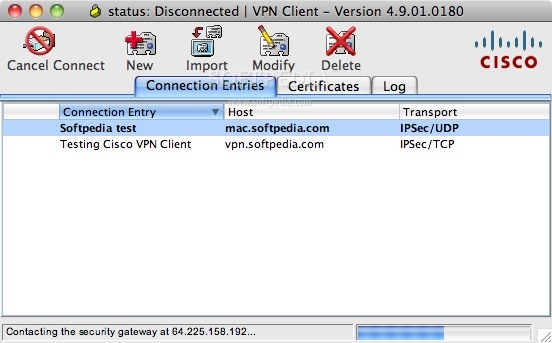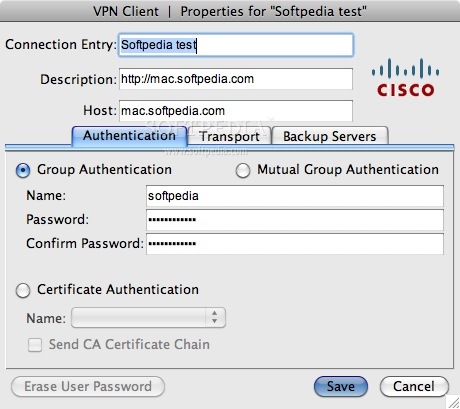

- MAC CISCO IPSEC VPN CLIENT MAC OS X
- MAC CISCO IPSEC VPN CLIENT INSTALL
- MAC CISCO IPSEC VPN CLIENT MANUAL
- MAC CISCO IPSEC VPN CLIENT PASSWORD
- MAC CISCO IPSEC VPN CLIENT PLUS
MAC CISCO IPSEC VPN CLIENT INSTALL
MAC CISCO IPSEC VPN CLIENT PASSWORD
Using this approach, I don't need to type in my vpn password every time, and I won't write my password to files without encryption :) $(sudo security find-generic-password -ws fookey) # look up from keychain opt/cisco/anyconnect/bin/vpn connect -s << EOMĠ # doesn't require two factor authorization Run the following bash script to connect (save it in /usr/local/bin).Save acc and pas pair in Keychain (under login not iCloud) with name fookey.Say I want to connect to with account acc and password pas. It even works well with two factor authorization.

The idea is to store my An圜onnect credential in Keychain, and use the An圜onnect's command line interface to access my saved credential and connect to VPN. I found a neat workaround with An圜onnect CLI and Keychain. Close Keychain Access and try connecting to your VPN again.When the /usr/libexec folder appears scroll to configd, select it and click Add.When the Go To Folder dialog appears, enter /usr/libexec.When the Finder window appears, press Cmd + Shift + G on your keyboard.The applications permitted to use this keychain item will be displayed below. Double-click the VPN(IPSec) whos kind is IPSec XAuth Password.On the right side of the screen scroll to the bottom and locate the two items called VPN(IPSec).On the left lower, under Category select All Items.On the left upper pane, under Keychains select System.Launch Keychain Access by clicking Applications > Utilities > Keychain Access.This is caused by a problem with the Keychain Access item for the VPN IPSec connection.
MAC CISCO IPSEC VPN CLIENT MAC OS X
Password even though you’ve previously saved it in the keychain YouĪre using IPSec on the built in VPN client on Mac OS X Snow Leopard Explanation: On Mac OS X Snow Leopard (10.6.x) you are prompted to enter your VPN

VPN ipsec Prompting Saved Password: Symptoms:
MAC CISCO IPSEC VPN CLIENT MANUAL
Save your changes and that's it – your saved passwordĪpparently the same manual fix of adding configd to the Keychain-allowed applications has to be applied for using the built-in ipsec-vpn tools. There, press Command+ Shift+ G, enter /usr/libexec, then pick configd in Select, /usr/libexec/configd, resides in a hidden folder.
MAC CISCO IPSEC VPN CLIENT PLUS
Open it, then on the Access Control tabĬlick the Plus button to add another application. Open the Keychain Access Application, select the System keychain andįind your saved XAuth password entry in the list. Turns out this is a just bug with a simple Properly, Mac OS X keeps nagging you to manually enter the passwordĮvery time you connect. You entered your password and it is apparently saved in the keychain Respectively when you set up the connection. Then a traditional username-password pair for XAuth, both of which youĬan enter and save in the Account Name and Password fields That makes it two layers of authentication: first, MachineĪuthentication with a password (Shared Secret) or an X509 certificate. Mac OS X Snow Leopard added the support for Cisco IPSec VPNĬonnections – that is, plain IPSec with XAuth authentication and This looks like a very annoying and longstanding bug in Mac OS X/macOS.ġ0.6: Save Cisco IPSec password in the Keychain:


 0 kommentar(er)
0 kommentar(er)
